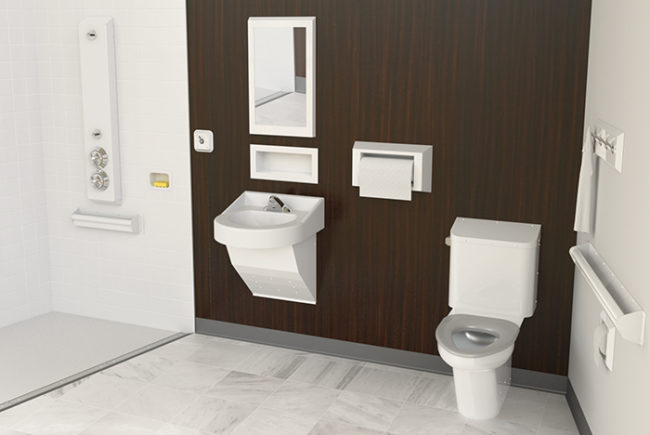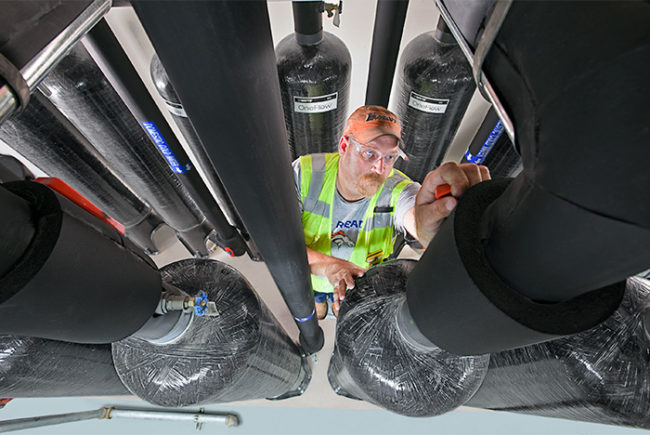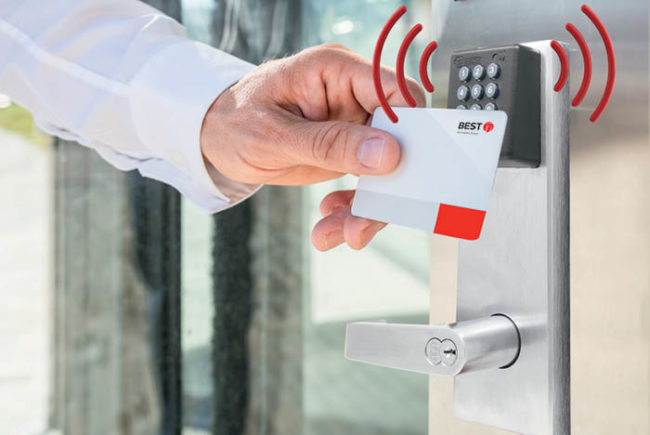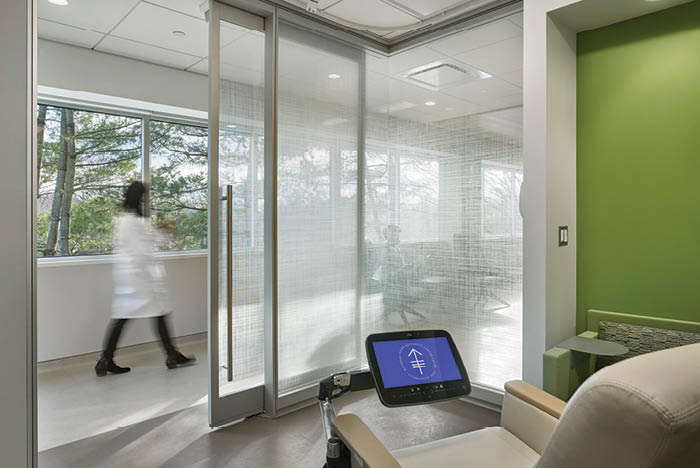
Health care furniture design is driven by cleanability, ergonomics, accommodating all body types, family-friendly qualities and aesthetic appeal, according to manufacturers.
Other features that furniture manufacturers strive to offer include flexibility, modularity and easy conversion for multiple purposes.
Additionally, given the impact of COVID-19 on the world of health care, infection control will be an even bigger goal in the near future, these manufacturers state.
Focus on cleanability
“After the fallout from the COVID-19 pandemic, we expect to see even more focus on the use of durable, cleanable materials and designing furniture with features such as open bases, minimal seams and functional crumb sweeps,” says Pam Krill, product manager at Steelcase Inc., Grand Rapids, Mich. Additionally, vendors say swing-open arms and removable seats that allow full access into difficult-to-reach areas help facilitate cleaning.
Furthermore, hospitals will be moving beyond cleanability to infection prevention in the selection and use of furnishings, says Michelle Ossmann, director of health care knowledge and insights at Herman Miller Inc., Zeeland, Mich.
Because SARS-CoV-2 lives on surfaces for days, it is important to explore methods to limit infectious spread, especially on high-touch surfaces. “This is not to minimize the importance of other considerations; however, infection prevention hits at health care’s No. 1 tenet: ‘First, do no harm,’” Ossmann says.
To that end, Herman Miller now offers the MicrobeCare antimicrobial coating on its Nemschoff line of furnishings. This antimicrobial coating actively kills germs. “MicrobeCare kills germs through a physical process and is safer than other antimicrobial solutions that kill through a chemical reaction or leaching process,” she says.
Multiple care environments
Furniture design and production will be based on lessons learned from COVID-19, agrees Debbie Breunig, vice president of architecture and design marketing at KI, Green Bay, Wis. She also sees the following trends coming into play: a continued shift to ambulatory and outpatient care; prioritizing the patient experience; and focus on space utilization, or flexibility within the built environment to leverage real estate in new construction as well as renovations.
Krill sees hospital facilities professionals striving for a less clinical look to put patients and families at ease and to provide a welcoming experience. This includes providing furnishing options that offer multiple postures, privacy and biophilic qualities. “Part of designing for the user experience includes providing for amenities such as power for charging devices, surfaces for writing or working, and thoughtful integration of electronic components,” she says.
More hospitals feature healing-space zones that allow caregivers and families to interact with patients, according to Lauri Waidner, marketing manager at Champion Manufacturing, Elkhart, Ind. “Since square footage is at a premium, careful consideration must be made to furnish these spaces with pieces that will adjust easily as needs for patient or guest seating change throughout the day. For example, designing recliners for 24/7 use is one of Champion’s specialties.”
Suzanne Fawley, health care interior and product design consultant at Stance Healthcare Inc., Kitchener, Ontario, sees a continued move toward concierge health care in behavioral health interior design, with designs for the personal needs of patients, caregivers and family. Those needs can be defined as physical, where furnishings must safely support and offer easy cleaning and maintenance; psychological, where the environment is nurturing and easy to navigate; and social, where the design considers the need for people to interact and their need for privacy.
The growing number of off-site health care facilities such as clinics, ambulatory units and medical office buildings poses some challenges to manufacturers that need to design furniture for these smaller buildings.
“Many services traditionally offered in an acute setting are being moved to outpatient settings where the cost per square foot is lower,” Waidner says. “That means patients coming to these environments present more complex health issues than are traditionally seen in outpatient settings. Medical furniture needs to adapt to accommodate higher-acuity patients and situations in these ambulatory settings, and that may require an evolution in patient seating.” Champion’s new Alō recliner is designed for use in these types of facilities.
The Caterina Collection of guest and bariatric chairs from Kwalu, Atlanta, is designed for off-site health care facilities as well. “It is an ideal single-seating option for reception and other waiting zones,” says Sylvia Nash, vice president of health care. “The chairs can stand alone or connect with a center or corner linking table. The chair frame, made of Kwalu’s proprietary material, is scuff-resistant, scratch-resistant and bleach-cleanable. The seat is removable for easy cleaning, and the back may be slat or upholstered.”
The third expansion of Mississauga, Ontario-based Allseating Corp.’s Exchange modular, soft-seating collection offers 180,000 possible variations, according to Michelle Crill, health care program director. The components come together to form single chairs, banquettes, private enclosures or custom configurations. “A myriad of options allows off-site facility managers to specify the system to suit their needs. For instance, wide, low arms with integrated power outlets can be specified for waiting areas to support laptop use.”
The Riva Lounge line of furnishings from Nemschoff provides a modern, upscale aesthetic for outpatient waiting spaces, according to Ossmann. “A choice of one-, two- or three-seat models and benches can be configured to meet a variety of needs. Coordinating tables allow facility managers to create a cohesive look throughout the outpatient environment.” In addition, the company has added new components to the carts in its Mora System for exam rooms and other outpatient care spaces. Mora carts are designed to blend seamlessly with Mora casework for a clean, consistent look across facilities.
Types of furnishings
A closer look at specific furniture types introduced to the health care market includes the following models and trends:
Seating and tables. Among furnishings recently introduced to the hospital market, the latest seating and tables are designed for comfort, durability and ease of use by a wide range of people. For example, Steelcase offers the Embold collection of seating, which integrates features such as a curved back, wood and metal legs, and a variety of size options with a graceful design and range of materials.
Kwalu has introduced the Modena Collection of seating and tables, which includes chairs with flexible backs for added comfort for people who are waiting or seated in a patient room. The arms and legs are made of Kwalu’s proprietary material, which is moisture-impervious, graffiti-resistant and bleach-cleanable. Modena occasional tables feature a 1-inch solid-surface top and a plinth base, which eliminates the need for cleaning beneath the product.
Katera Cafe Stools from KI have a 350-pound weight rating and ample seating area to support a wide range of people. Its well-proportioned frame invites those of any size to sit with ease, the company states. Specifiers can mix and match materials for a wide range of aesthetic options. Also, the seat and back are available in poly, wood and upholstered versions, and frames are available in powder coat or chrome finishes. The cafe stools are suitable for environments ranging from waiting rooms and patient rooms to cafeterias and meeting areas.
Stance Healthcare has introduced the Resilia Table Series, a collection of side and coffee tables that use Forbo Marmoleum as its cylinder surround. The material is high-impact and will not chip as will typical laminate cylinder tables. Stance Healthcare also offers Frontier case goods for behavioral health facilities. The collection consists of a bed, flip-style bedside cabinet, desk and shelving. All coordinating units are constructed with high-impact polyethylene. In addition, the company has introduced the Attessa Jr. modular lounge series, which provides flexible seating options in pediatric-focused areas.
Recliners. Champion Manufacturing has unveiled the Alō recliner, which is available in many customizable selections. It has two back styles, various vanity panel selections, an upgraded standard color palette, and patient empowerment items such as powered reclining, a USB port, and heat and massage. “Acute functionality has been engineered into the Alō. This includes swing-away arms and a removable seat for ease of cleaning and disinfection, and flat-body Trendelenburg positioning for acute reactions,” Waidner says. It also features 4-inch twin-wheel casters, a retractable foot tray and a push handle for patient transport.
The Foster Patient Recliner from Allseating Corp., which is Healthier Hospitals Initiative-compliant, features removable covers, and central brake and steer, according to Crill. “The central brake and steer allows the recliner to be easily locked in place for safe egress and ingress, and the chair’s arms easily move out of the way for side access. The removable seat and back cushions offer cleanability. The recliner also lays flat to create a sleep surface to better support family during the healing process within small patient rooms where an extra sleep surface isn’t an option.”
Casework. Convey casework from Steelcase offers facilities managers a wide spectrum of modular components that align along a continuous rail and micro-adjust for a perfect fit, according to Krill. Cabinetry is available in modular and parametric sizes with solid-surface tops and integrated sink bowls, so it looks, feels and fits like custom carpentry. Steelcase also offers freestanding separation screens, which are designed with clear and opaque finishes to support screening stations, waiting areas and privacy between patients. Highly cleanable and movable, they offer a flexible solution wherever boundaries are needed, Krill adds.
Taking the separation screen concept to another level, CAMA Inc., New Haven, Conn., has introduced the Skyline Design, Dignity Glass with CAMAflage pattern. The key feature is a glass privacy/dignity screen that is architecturally installed and replaces traditional screening such as cubicle curtains. “It considers harm through the spread of contact infection; it considers the person through privacy and dignity; it considers care through visibility and safety; and it considers healing through beauty,” says Rosalyn Cama, the company’s president.
CAMAflage patterns offer hygienic, soothing and flexible interiors. Based on research into the needs of patients and providers and current solutions such as cubicle curtains, “CAMAflage is a line of three inspiring glass patterns — all customizable according to client specifications — that represent the leading edge in evidence-based health care design,” Cama says.
Herman Miller has introduced Commend, a modular workstation for care teams that combines aesthetics and durability with intelligence and data capacity, according to Ossmann. Like all of the company’s prefabricated solutions, Commend can be deployed quickly and can help facilities professionals open new spaces or renovate existing ones while maintaining a consistent aesthetic.
Herman Miller’s health care subsidiary, Nemschoff, offers the Merge II Flop Sofa for patient rooms. It includes an adjustable table that allows family members and guests to eat, work and play games while visiting their loved ones. Merge II also features upholstered arms and a laminate center table as well as integrated power and intuitive sleep conversion.
Flexible future
Moving forward, health care furniture manufacturers expect to see continued investment and movement toward flexibility in facility and space design, and convertible furnishings that can serve multiple purposes.
They also see hospitals and other health facilities investing in more solid-surface furnishings that offer long-term cleanability to help combat current and emerging antibiotic-resistant bacterial, fungal and viral threats.
Neal Lorenzi is a freelance writer and regular contributor based in Mundelein, Ill.
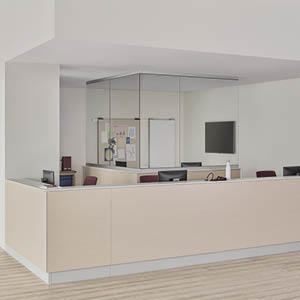
WORKING SMARTER
Commend, a modular workstation for care teams, combines aesthetics and durability with intelligence and data capacity. Herman Miller Inc.
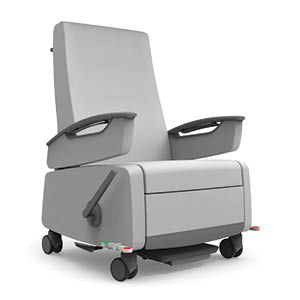
MOVING ALONG
The Foster Patient Recliner is Healthier Hospitals Initiative-compliant and features removable covers, and central brake and steer. Allseating Corp.
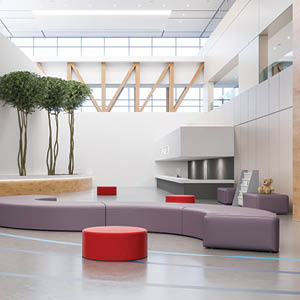
CHILD’S PLAY
The Attessa Jr. modular lounge series provides flexible seating options in pediatric-focused areas. Stance Healthcare Inc.
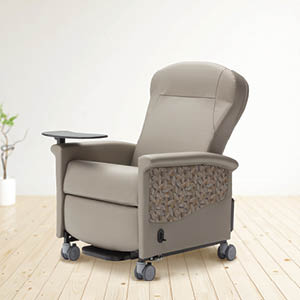
EASY ADJUSTMENT
The Alo recliner includes swing-away arms and a removable seat for ease of cleaning and disinfection. Champion Manufacturing
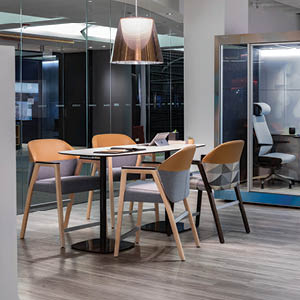
FLEX TIME
The Embold collection of seating gives health care organizations the flexibility to adapt waiting spaces over time to meet changing needs. Steelcase Inc.
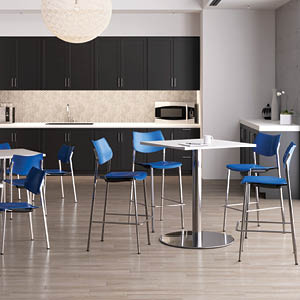
MULTIPLE OPTIONS
Katera cafe stools are suitable for health care environments ranging from waiting rooms and patient rooms to cafeterias. KI
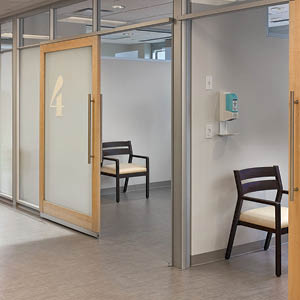
TAKE A LOAD OFF
The Caterina Guest slat back chairs are thoughtfully designed chairs featuring clean lines; a spacious removable seat, an angled back, angled, contemporary arms to facilitate ingress and egress and wall saver back legs. Kwalu
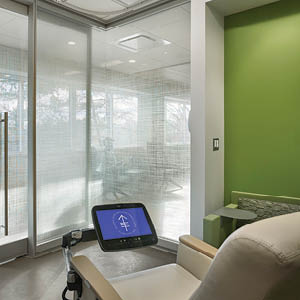
PRIVACY FIRST
The Skyline Design Dignity Glass with CAMAflage pattern features a glass privacy/dignity screen. CAMA Inc.



